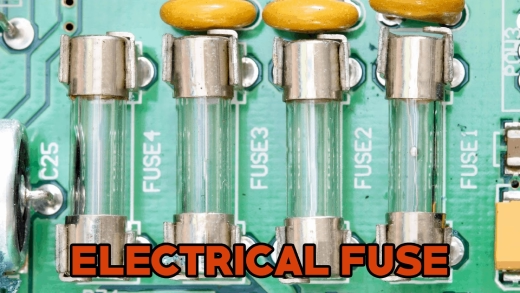How Does a Fuse Work? [Full Guide]

How Does a Fuse Work
Electrical fuses are used to prevent overcurrent flows and temperature increases in systems. Most older homes still have them, and many of them comply with code. Fuse wiring is a complicated topic, but this article, which is about how does a fuse works, will help you understand it better.
What's an Electric Fuse?

What's an Electric Fuse?
Basically, a fuse box divides incoming voltage into many circuits, acting as the central node in an electrical system. All the electrical systems in your home and office are powered by the main switchboard, breaker panel, or circuit board. A total of six to twelve cartridge-style fuses are available. A 60 amp fuse board was common in ancient times. The combined power of domestic electrical systems is 200 amps.
How Does a Fuse Work: Basics
In order to protect a device from dangerous current levels, a fuse is a simple and highly effective solution:
Power is dissipated by current flowing through a conductor which has a nonzero resistance.
Heat is a form of power dissipation.
Conductors become hot when they are heated.
A fuse becomes an open circuit when its melting point is exceeded by amplitude and duration together.
Fuse operations may seem straightforward, but there are a few subtleties to remember. It is important to understand some important details about fuses and how they behave and are used in the remainder of this article.
Types of Fuses
Fires and other damages can be prevented by having the proper fuse box installed. A fuse may be one of three types:
Type-T (Edison base) Fuses: In almost every household circuit with 120 to 125 volts, these are standard fuses.
Cartridge Fuses: Fuse boxes control the power of 240-volt appliance circuits by using these fuses.
Type-S (Rejection base) Fuses: There are fuses that come in Edison-type sockets with fuses and adapters.
Why Do Fuses Blow?
Several reasons can cause a fuse to blow, including:
Overload Fuse Blows: An electrical overload can cause the circuit to open and the fuse to blow when the current flow is six times greater than the normal current. A circuit overload usually occurs when more than one device is hooked up at the same time.
Ground Fault Fuse Blows: It is possible to cause a ground fault with a grounded metal pipe, electrical box, or your hand.
Short Circuit Fuse Blows: Low-resistance electricity paths can be shorted out by receiving high-volume currents. Electric cables can be shorted by water if a nail or screw penetrates them. Metal can melt, arch fires can occur, insulation damage can occur, and conductors can vaporize when the current is thousand times greater than the normal current.
Function of Fuse
Electrical fuses protect functional electrical circuits from overcurrents in the field of electrical engineering. The fuse performs several major functions, which are listed below.
Interferes with the passage of electricity through the human body
Ensures that faulty circuit operation does not result in device failure
Short-circuit prevention is provided by the fuse
Ensures that there are no overloads or blackouts
Mismatched loads can cause damage
In addition to the ampere rating and voltage rating of the fuse, there is also an interruption rating listed on the fuse.
Faqs
Question 1: How does a fuse work in a short circuit?
Answer: Short circuits and too many appliances connected to one wire can cause the current to be too great. Fuse wires melt quickly, preventing a fire from starting because a circuit is broken.
Question 2: As an explanation of how fuses work, why do we use fuses?
Answer: Electrical safety devices called fuses are electrical safety devices that protect electrical circuits from overcurrents. Whenever too much current flows through a metal wire or strip, it melts, disrupting its function.
Question 3: Why do fuses keep blowing?
Answer: The cause of this problem can be attributed to many factors. A fuse will usually blow if its amp rating is exceeded by the current flowing from the power source. Electrical currents alter their path or stray from the intended path. This issue can lead to severe problems if the current does not flow correctly.
Question 4: Can a fuse be bad and not blown?
Answer: An old fuse may not necessarily be blown, but it may be badly damaged. In this case, a test light or a multimeter are the best tools for testing. It's easy to check whether a fuse is running by using these tools, both of which are relatively inexpensive.
Final Verdict
Electric fire can threaten human lives if there is an overflow of electricity. To secure your home against power-related issues, a suitable device (such as a fuse or circuit breaker) must be installed. Choosing an electrician with experience and qualifications will help you make the right choice. That's it for today guys, if you love our article which is about how does a fuse work, then make sure to let us know in the comment section. Thank You!
Related Articles
How Long Do Electrolytic Capacitors Last
How to Charge Capacitor Without Resistor?
What is Hartley Oscillator: Circuit, Working, and its Applications
What is an Integrated Circuit?
What is an Integrated Circuit? Applications, Functions and Types (Guide)
Integrated circuit chip: Types, Applications, and FAQ
Microprocessor Vs Integrated Circuit: What’s the Differences?
Varistors: How Do They Safeguard Circuits?
Simple Electronic Circuits for Beginners
Phototransistor : Circuit Pinout & Principle
Watt Amplifier Circuit:Types,Principle and Applications
LM386 Audio Amplifier Circuit: Features, Applications and Datasheet










